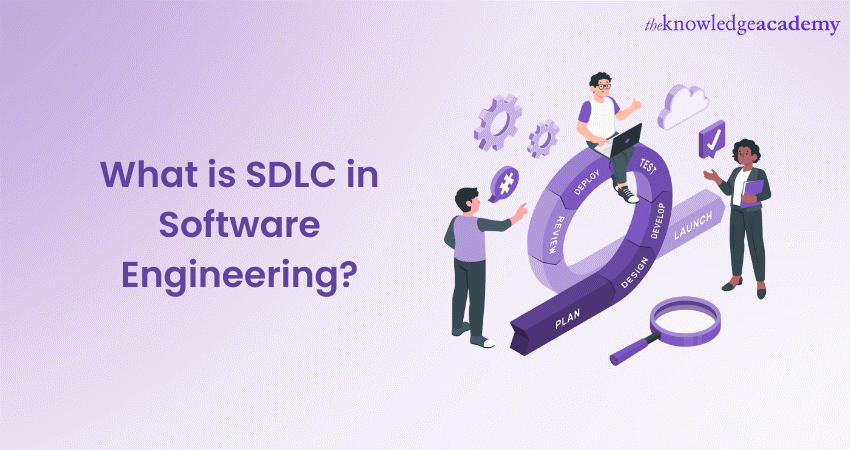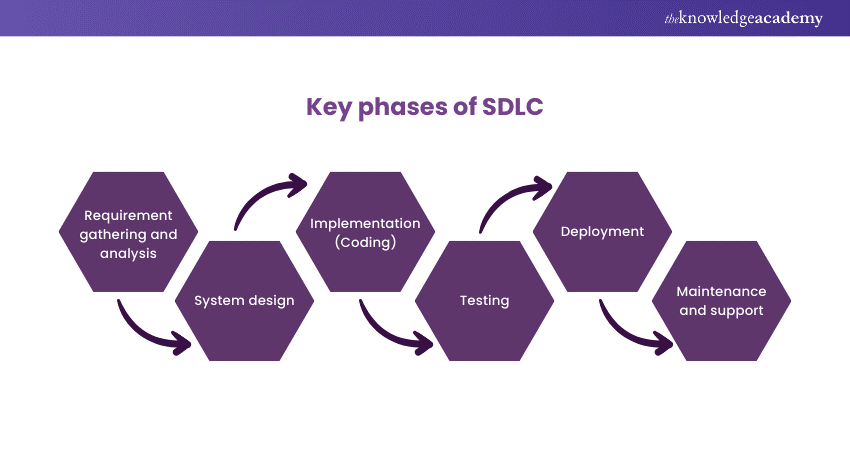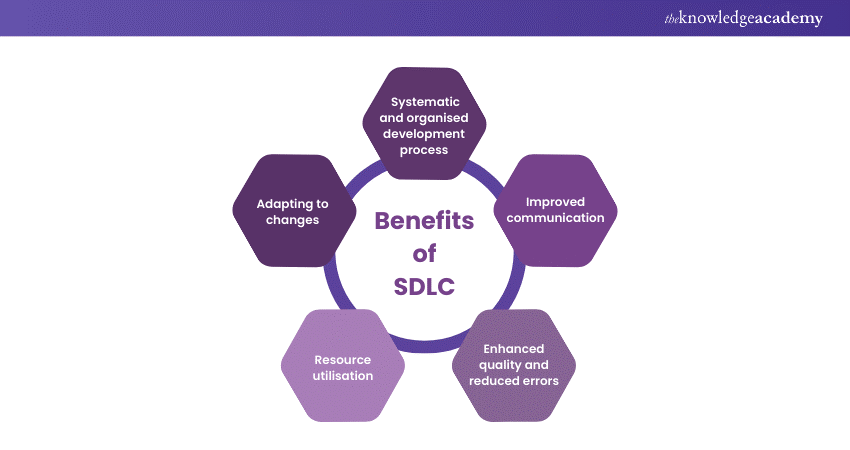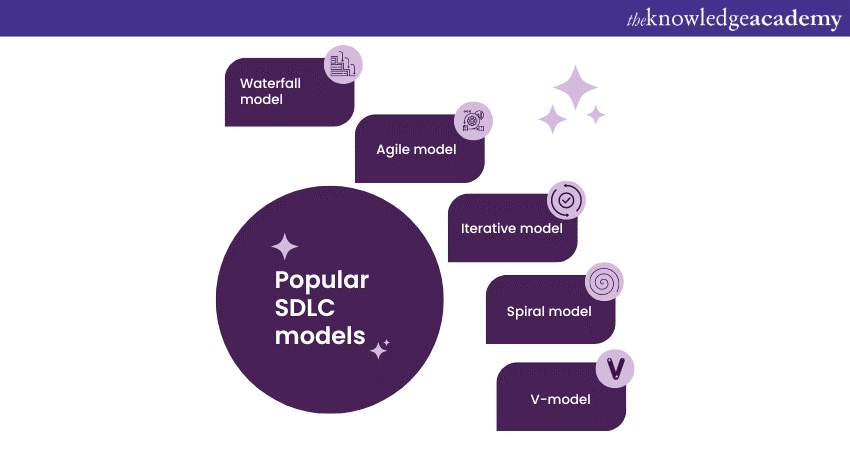We may not have the course you’re looking for. If you enquire or give us a call on +800 312616 and speak to our training experts, we may still be able to help with your training requirements.
Training Outcomes Within Your Budget!
We ensure quality, budget-alignment, and timely delivery by our expert instructors.

Innovation and precision drive technological progress, and therefore understanding “What is SDLC in Software Engineering?” is necessary as it forms the bedrock of successful Software Development. The Software Development Life Cycle (SDLC) stands as a fundamental framework that guides the intricate journey from conceptualisation to deployment.
One of the core concepts of Software Engineering is the Software Development Life Cycle (SDLC), which is a framework that defines the stages and activities involved in software projects. In this blog, we will explore What is SDLC in Software Engineering and how it can help us achieve better Software Engineering outcomes.
Table of Contents
1) What is SDLC?
2) Why is SDLC important in Software Engineering?
3) Key phases of SDLC
4) Benefits of SDLC
5) Popular SDLC models
6) Challenges in SDLC implementation
7) Conclusion
What is SDLC?
The Software Development Life Cycle (SDLC) is a key methodology that guides Developers, Designers, Testers, and stakeholders through the complex process of software creation.
The Software Development Life Cycle (SDLC) is a well-structured and systematic process that defines the stages and activities involved in conceptualising, creating, building, testing, deploying, and maintaining software applications. This comprehensive methodology coordinates the entire Software Development process, offering a structured roadmap that turns an idea into a tangible and functional product.
SDLC is like a roadmap that directs a team of diverse professionals through the intricate Software Development landscape. It provides a step-by-step guide, ensuring that no critical aspect is missed or ignored during the process. By dividing the entire process into distinct phases, SDLC makes a potentially daunting task into manageable steps, enhancing efficiency and organisation.
SDLC consists of a sequence of distinct phases, each serving a unique purpose:
a) Requirement gathering and analysis: The foundation of any software project is a deep understanding of what the software should achieve. This phase involves engaging with stakeholders, gathering requirements, and analysing the project scope.
b) System design: With requirements in hand, the design phase outlines how the software will be structured, determining its architecture, User Interface (UI), and overall functionality.
c) Implementation (Coding): The actual coding process occurs during this phase. Developers bring the design to life by writing the source code and following coding standards and best practices.
d) Testing: Rigorous Testing is a hallmark of SDLC. Different Testing methodologies, such as Unit Testing, Integration Testing, and User Acceptance Testing, are used to identify and fix defects.
e) Deployment: Once testing is completed, the software is deployed in the production environment, making it available to users.
f) Maintenance and support: Even after deployment, the process continues. Care and support ensure the software remains functional, receives updates, and addresses emerging issues.
Why is SDLC Important in Software Engineering?
Software Development is a complex process that involves dealing with dynamic requirements, evolving technologies, and diverse teams. To manage this process effectively, the SDLC methodology offers a structured approach with clear outcomes at each stage of the Software Development process. This way, all stakeholders can align on Software Development objectives and expectations from the beginning and follow a plan to achieve them.
Its significance manifests in several ways:
a) Clarity and consistency: SDLC creates a clear framework, ensuring that every team member understands their roles, responsibilities, and the project's overall direction. This alignment avoids misunderstandings and promotes consistent progress.
b) Effective communication: In a collaborative environment with Developers, Designers, Testers, and stakeholders, communication can be difficult. SDLC enables Effective Communication by defining deliverables and expectations at each phase, reducing ambiguity.
c) Risk management: Software Development is full of uncertainties and risks. SDLC's phased approach allows teams to identify potential risks early, allowing for proactive mitigation strategies.
d) Quality assurance: The iterative testing and evaluation processes integral to SDLC improve the quality of the final product. Rigorous testing at different stages reduces errors and bugs, leading to a more reliable Software Application.
e) Resource optimisation: SDLC helps resource allocation, ensuring that time, budget, and human resources are used optimally. This efficient distribution increases the likelihood of timely project completion.
Explore our comprehensive Software Engineering Course and embark on a journey of mastering the intricacies of modern Software Development.
Key phases of SDLC
Now that we have discussed What is SDLC in Software Engineering, let's see what are the key phases of SDLC. SDLC consists of a sequence of distinct phases, each serving a unique purpose and contributing to the Software Development process. The key phases of SDLC are:

Requirement gathering and analysis
The foundation of any successful software project is an in-depth understanding of what needs to be built. During this phase, Developers and project stakeholders collaborate to collect and document the requirements for the software.
This involves engaging with clients, end-users, and domain experts to identify the software's purpose, features, functionalities, and user expectations. Clear and detailed requirements lay the groundwork for subsequent phases and ensure the development aligns with the goals.
Are you ready to take your Java programming abilities to the next level? Our comprehensive course in Java Programming and Software Engineering Fundamentals Training is your pathway to success!
System design
With requirements in hand, the system design phase takes centre stage. Architects and designers create a blueprint outlining how the software will be programmed and how its various components will interact. This includes defining the software's architecture, data flow, User Interfaces, and more. The system design phase transforms abstract concepts into concrete plans, setting the stage for development.
Implementation (Coding)
The implementation phase breathes life into the design. Developers write the source code, translating the design specifications into executable computer instructions. Coding standards, best practices and Programming Languages are employed to ensure clean, maintainable, and efficient code. This phase demands a meticulous approach as the code's quality directly influences the final product's reliability and performance.
Testing
Quality assurance is paramount in Software Development, and the testing phase is critical in ensuring that the software meets quality standards. Various types of testing, namely unit, integration, and system, are conducted to identify defects, errors, and inconsistencies. Rigorous testing helps identify and rectify issues early in development, reducing the likelihood of significant problems during later stages.
Deployment
Once the software has successfully passed the testing phase, it is ready for deployment. During this phase, the software is installed and made accessible to end-users. Deployment involves configuring the software for the target environment, ensuring it runs smoothly and meets performance expectations. This phase demands coordination between Developers, System administrators, and other stakeholders to seamlessly transition from development to production.
Maintenance and support
The journey doesn't end with deployment; it marks the beginning of a new phase. Maintenance and support are essential to address any issues, bugs, or updates arising after the software is used. Regular updates, patches, and enhancements ensure the software remains relevant, functional, and secure. User feedback and monitoring are crucial in this phase, guiding continuous improvements and refinements.
Are you ready to take your Java programming abilities to the next level? Our comprehensive course in Java Programming and software Engineering Fundamentals Training is your pathway to success!
Benefits of SDLC
As we have already discussed What is SDLC in Software Engineering, now let's see what benefits it offers. SDLC is a methodical, systematic process for creating software or a mobile application from quality, accuracy, and precision. It provides structure, clarity, efficiency, and control for projects, as well as a paper trail and a system of checks and balances. Some of the benefits of SDLC are:

a) Orderly progression: SDLC breaks down the Software Development journey into well-defined phases, ensuring each step is completed before moving to the next, creating an orderly progression that minimises confusion and maximises efficiency.
b) Effective communication and collaboration: SDLC facilitates effective communication and collaboration among diverse teams involved in Software Development, such as Developers, Designers, Testers, Project Managers, and Stakeholders. Clear documentation, well-defined deliverables, and standardised processes ensure everyone is on the same page, fostering synergy and reducing misunderstandings.
c) High quality and reliability: SDLC incorporates rigorous testing and quality checks at various stages of development, identifying and fixing defects, errors, and inconsistencies early in the process, resulting in higher quality, more reliability, and fewer post-release problems.
d) Optimal resource utilisation: SDLC offers a clear roadmap that assists project managers in organising tasks, setting milestones, and managing resources effectively, optimising time, budget, and human capital, leading to timely deliveries and efficient resource utilisation.
e) Adaptability to changing requirements: SDLC's structured yet flexible approach accommodates changing requirements, empowering teams to adapt to evolving user needs and market trends, ensuring that the end product aligns with user expectations and project goals.
Popular SDLC models
Different projects have varying requirements, timelines, and levels of complexity. This reality has given rise to various Software Development Life Cycle (SDLC) models, each offering a distinct approach to orchestrating the development journey. These models provide frameworks that empower development teams to adapt to project-specific needs, fostering efficiency and success.

Waterfall model
The Waterfall Model follows a linear approach to SDLC. It resembles a waterfall, where each phase sequentially flows into the next. The key steps—requirement gathering, system design, implementation, testing, deployment, and maintenance—are executed in a predefined order. It is ideal for projects with well-defined and stable requirements, where changes are expected to be minimal. However, its rigid structure can be a limitation when dealing with evolving needs or when user feedback is crucial.
Agile model
Agile is a dynamic, iterative approach emphasising collaboration, adaptability, and incremental development. Unlike the Waterfall model, Agile divides the project into small, manageable sprint units. Each sprint involves requirement analysis, design, coding, testing, and deployment.
The Agile model promotes constant user feedback and continuous improvement, enabling teams to adjust courses as project requirements evolve. This adaptability makes Agile suitable for projects with changing conditions and for groups that prioritise collaboration and quick releases.
Iterative model
The Iterative model shares similarities with Agile but takes a more measured approach. It involves successive development and testing cycles, allowing for refinement with each iteration. Each process produces a working version of the software, and feedback from one iteration informs the next.
This model is beneficial when the project's requirements still need to be fully understood initially. Iterative development allows for gradual exploration and refinement, making it suitable for complex projects or dynamic environments.
Spiral model
The Spiral model integrates elements of both the Waterfall and Iterative models. It places a strong emphasis on risk assessment and management. The development process occurs in cycles, each consisting of four phases: planning, risk analysis, engineering, and evaluation. The Spiral model is well-suited for projects where Risk Management is critical and for scenarios where requirements are subject to change and must be refined over time.
V-model
The V-Model, the validation and verification model, aligns testing with each development phase. It mirrors the Waterfall model's sequence of steps but emphasises the relationship between testing and development. For every development phase, a corresponding testing phase is conducted. This approach ensures that testing activities are well-defined and executed parallel with development, resulting in early detection of defects and discrepancies.
Challenges in SDLC implementation
SDLC is a powerful methodology that can help Software Engineers create high-quality software products that meet user needs and expectations. However, SDLC is not without its challenges. Software Development is a complex and dynamic process that involves many uncertainties, risks, and changes. Here we will discuss some of the common challenges in SDLC implementation and how to address them effectively:
a) Changing requirements
Sometimes, user needs can change quickly in a fast-paced technology world. It can be a problem for SDLC, as the software requirements might need to change in the middle of the project. It can affect the project's schedule and budget. To solve this problem, using Agile or Iterative SDLC models can help teams change the software requirements easily. Talking to stakeholders often and writing down the changes can also help teams keep up with the changing needs.
b) Estimation challenges
It is hard to estimate how much time and resources each phase of SDLC will need. If the estimate is too high, it can waste time and money. If the estimate is too low, it can cause delays and poor quality. To solve this problem, using data from past projects, asking experienced team members, and using methods like expert judgment and parametric analysis can help teams make better estimates.
c) Flexibility vs structure
Flexibility is important for making changes and improvements to the software. However, too much flexibility can cause confusion and disorder. Finding the right balance between being flexible and being structured is a constant challenge. To solve this problem, using frameworks like Agile, which mixes design with flexibility, can help teams stay focused while adapting to changing requirements. Communicating and collaborating with the team regularly is also important to make sure that flexibility is used wisely.
d) Communication issues
Communication is essential for the success of SDLC. Poor communication or lack of teamwork can lead to mistakes, missed requirements, and unhappy expectations. To solve this problem, having regular meetings, setting up clear communication channels, and using collaboration tools can improve team harmony and make sure everyone is on the same page.
e) Testing difficulties
Testing is important for finding and fixing errors and ensuring software quality. However, more testing or complete testing can still cause some issues in the software. To solve this problem, giving enough time and resources to testing, having a clear testing plan, and using automated testing tools can improve the completeness and accuracy of testing processes.
Conclusion
In the domain of technology, understanding “What is SDLC in Software Engineering?” is paramount. The Software Development Life Cycle (SDLC) serves as a guiding framework, orchestrating the journey from concept to deployment. It empowers developers to navigate complexities, adapt to changes, and ensure high-quality outcomes. With its structured phases, communication enhancements, and flexibility, SDLC is the cornerstone that transforms ideas into functional software marvels.
Discover the art of crafting exceptional Software with our Software Development Lifecycle Training and elevate your understanding of SDLC.
Frequently Asked Questions

The SDLC defining stage is the second stage of the Software Development Life Cycle, where the requirements for the software are specified and documented. This stage involves engaging with stakeholders, gathering requirements, and analysing the project scope. This stage sets the foundation for software design and development.

SDLC in system engineering is the process of planning, creating, testing, and deploying a system, which can be a software application, a hardware solution, or an integrated system combining both. In system engineering, SDLC follows a structured and systematic approach that defines the stages and activities involved in system development.

The Knowledge Academy takes global learning to new heights, offering over 30,000 online courses across 490+ locations in 220 countries. This expansive reach ensures accessibility and convenience for learners worldwide.
Alongside our diverse Online Course Catalogue, encompassing 17 major categories, we go the extra mile by providing a plethora of free educational Online Resources like News updates, Blogs, videos, webinars, and interview questions. Tailoring learning experiences further, professionals can maximise value with customisable Course Bundles of TKA.

The Knowledge Academy’s Knowledge Pass, a prepaid voucher, adds another layer of flexibility, allowing course bookings over a 12-month period. Join us on a journey where education knows no bounds.

The Knowledge Academy offers various Software Engineering courses, including Software Design Training and Software Development Lifecycle Training . These courses cater to different skill levels, providing comprehensive insights into SDLC In Software Testing.
Our Programming & DevOps blogs covers a range of topics related to PRINCE2, offering valuable resources, best practices, and industry insights. Whether you are a beginner or looking to advance your Project Management skills, The Knowledge Academy's diverse courses and informative blogs have you covered.







 Top Rated Course
Top Rated Course




 If you wish to make any changes to your course, please
If you wish to make any changes to your course, please


